Norton Family Review 2025: Good, But Is It Worth The Cost?
Norton Family Overview
Norton Family claims to have everything you need in a parental control app, such as screen time limits, a powerful web filter, location tracking, app blocking, and school restrictions. The monthly price looks good to me, and you can monitor up to 10 devices at once.
I downloaded and installed Norton Family using the 30-day free trial. The installation and setup were fast and easy, but I wasn’t impressed with some of the features. The web filtering feature only works on the Norton Family browser, and you can’t access App Supervision on iOS devices.
Despite this, I found that Norton Family remains one of the best parental control apps that I’ve tested. You can easily create rules for each child and monitor them from anywhere. Even if your kids are tech-savvy, it will be hard for them to get around the supervision or uninstall the app.
In a Rush? Here’s a 1-Minute Summary
- Customizable web filter — Includes 47 categories of filters that allow you to block access to inappropriate sites on your child’s devices. See how you can add sites to the web filter.
- Manage screen time rules — Define screen time limits for each child based on their routines or just set a daily limit for them. Find out more about the screen time feature.
- Set rules for school time — Manage the websites your children can visit during school time, including online activities they are allowed to engage in. Here’s how Norton Family helps you ensure responsible phone use.
- Remote app monitoring — Shows you an updated list of all the apps on your child’s phone, how much each app is used, and an option to block an app from opening. Jump here to see how this feature works.
- Real-time location tracking with geofencing — Monitor your child’s location and get instant notifications when the child goes up to 10,500 feet outside a set boundary. See how to use location tracking in the Norton Family app.
- Monitor and block access to videos — Monitor the video content your child is watching on YouTube and Hulu. You can also block access to these platforms at any time. Jump here to see which devices and browsers Norton supports.
- Search supervision — Monitor each child’s search history on major search engines like Google, Bing, YouTube, Ask, and Yahoo to know what’s going on in their life. Here’s how you can use search supervision in Norton Family.
Features
Norton Family allows you to customize the web filters and time restrictions for each of your kids’ devices, track their location in real time, and see all the latest updates and alerts in an easy-to-use parent dashboard.
Here’s a quick summary of Norton Family’s features:
| Best Price | $49.99/year – No device limits |
| Free Trial | 30 days |
| Money-back guarantee | 60 days |
| Firewall | Yes |
| Web Filter | 45+ categories |
| Screen Time Management | Yes |
| Location Tracking | Yes – Not available in most European countries |
| Geofencing | Yes – Not available in most European countries |
| Call and SMS Monitoring | No |
| App Management | Yes – Not available on iOS devices |
| SOS Button | Yes |
| Customer Service | Live chat, phone support, FAQ |
| Platforms | PC, Android, iOS |
| VPN included | Yes |
Web Filters — Block Access to Inappropriate Sites Based on Your Child’s Age
Norton Family’s web filtering capabilities allow you to block inappropriate websites and content categories on your child’s device. You can set this restriction manually or based on the age of the child. This way, you can be sure the child is only accessing age-appropriate content online, even when you’re not looking.
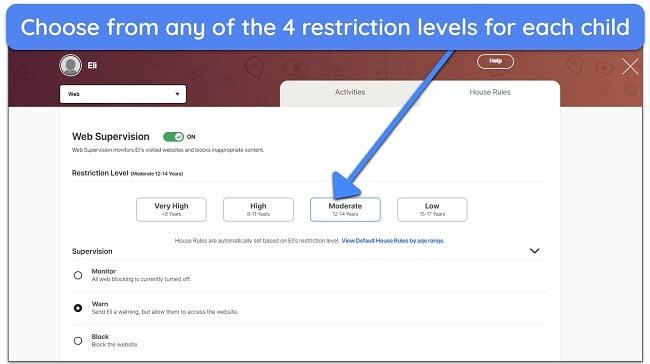 The Web Supervision feature is very easy to use
The Web Supervision feature is very easy to useWhen I want to restrict my child from visiting specific sites, I set the restriction to Very High or High. Moderate and Low only show them a warning, but still let the child access the sites if they want to. You can also set a custom restriction level if you want your kids to be able to visit any site they want but with a notification sent to you of the sites they visit.
I like that Norton Family’s web filtering feature comes with a total of 47 categories, such as news, violence, porn, suicide, alcohol, and drugs. It uses smart AI to categorize every website based on the text, metadata, and images found on these sites. You can always add additional websites to the filter.
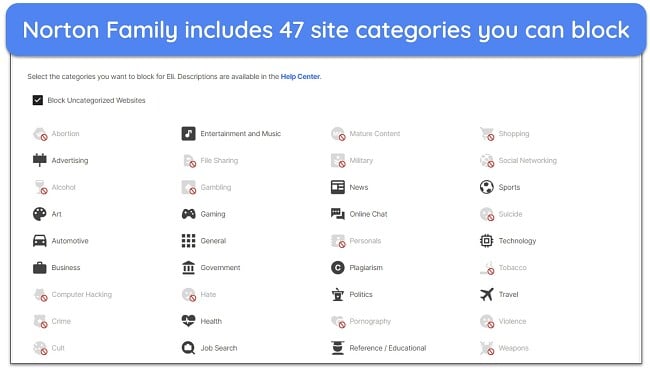 You can also add more websites to the list of sites to be blocked
You can also add more websites to the list of sites to be blockedOnce you set a restriction, it’s automatically updated on the child’s device, and they also get an instant notification about the change. I also like that it allows kids to request access to a blocked site, especially if they need to use it. The request shows up via email as a notification, and you can click the accompanying link to log in and approve it.
The web filtering works on iOS, Android, Windows, Norton Family browser, and common web browsers like Chrome, Firefox, and Edge. Norton Family also shows you daily, weekly, bi-weekly, and monthly reports of your child’s web usage. The reports show which blacklisted site categories they tried to access and the whitelisted site categories they visited.
Time Limits — Control How Long Your Child Spends on Their Device
The Time Supervision feature allows you to actively monitor each child’s device use and enforce time limits. It has 4 default schedule categories based on a child’s age, with older kids getting more time. However, the time limit is quite general and isn’t enforced during school hours.
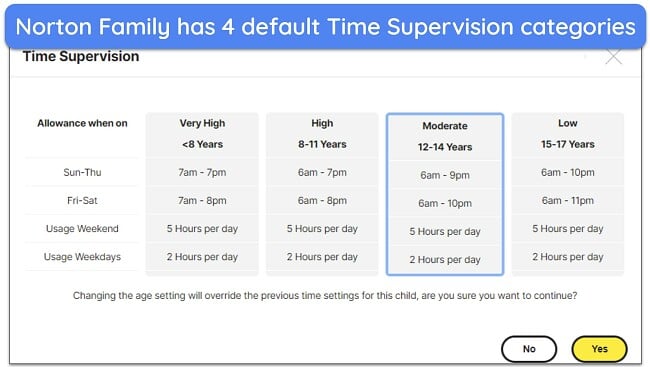 The default screen schedule rules are very general
The default screen schedule rules are very generalBut you can also set a custom time limit schedule that works best for your child’s daily routines. I find the default ones more useful for older kids. I prefer to set a custom time limit for the younger ones. You can do this by manually selecting the allowed and blocked screen hours and then applying it to as many days in the week as you want.
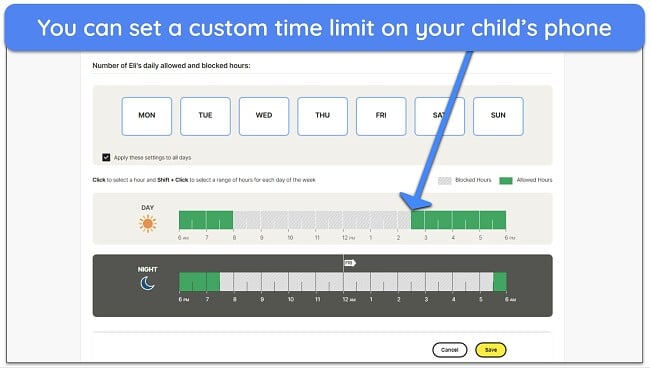 Green represents allowed time, while hours marked gray are blocked on the child’s phone
Green represents allowed time, while hours marked gray are blocked on the child’s phoneThe settings for the custom time limit are split into 24 hours (day and night), allowing you to add or block screen time on your child’s phone in increments of 30 minutes. The only challenge with this is that it doesn’t let you decide exactly how much time you want the kids to spend on their phones.
You can access the time limits feature on iOS, Android, and Windows. Whenever you make a change, it takes effect immediately. Norton Family also allows the child to request more time if necessary. I get the notification in my dashboard and email and can grant the request easily.
There’s also an Instant Lock feature, which is accessible from your dashboard, that allows you to block all apps, including outgoing phone calls. However, you will be prompted to add at least 1 emergency contact that your child can call before you can enable Instant Lock.
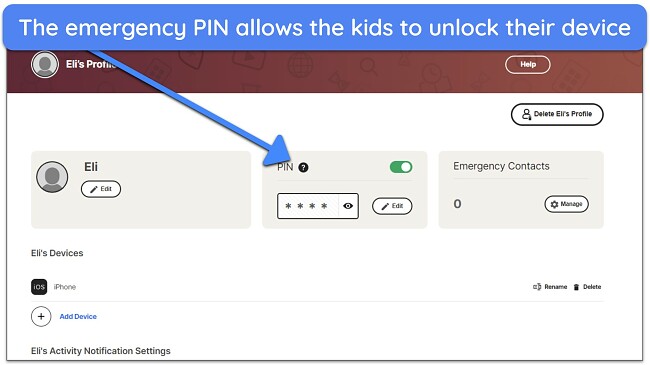
Norton Family also provides a 4-digit PIN that allows your kids to unlock their devices instantly without requesting permission from you. This is useful when there’s an emergency. You can find this PIN in the parent’s dashboard at the top of each child’s profile.
School Restrictions — Ensure Responsible Phone Use During School Hours
Kids can get easily distracted from their studies, so the School Time features enable parents to ensure their kids have supervised access to their phones or tablets during school hours. This feature is different from the Web filtering and Time Supervision features. It is a combination of both, as it allows you to limit internet access to only the websites your kids need at school.
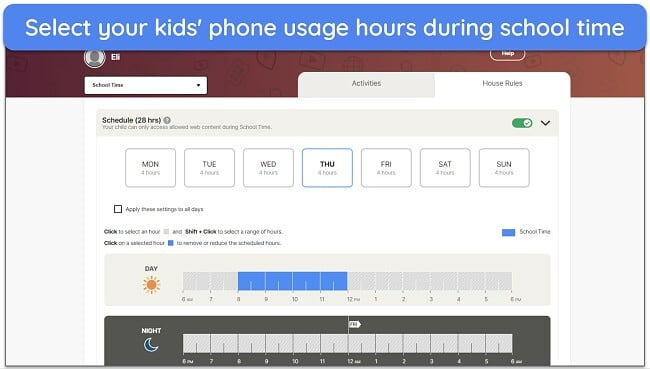 You can create a custom selection of school hours for each child
You can create a custom selection of school hours for each childNorton Family’s School Time feature is a good addition, but it’s still disappointing since you can only block websites and not apps. It would be better if you could also restrict access to apps that might be a distraction to the child during school hours.
The websites you want to allow or block can be added manually in the dashboard. Norton Family already includes a list of 41 website categories to select from, such as gaming, drugs, abortion, alcohol, art, gambling, and cyberbullying. I tested the feature right after activating it, and I couldn’t access potentially distracting sites like YouTube and Reddit.
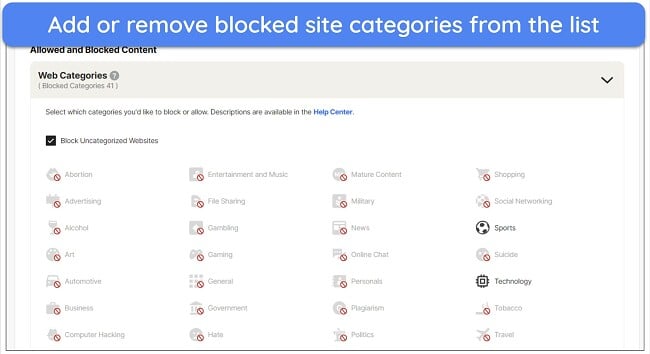 I can also add to the blocked site categories if it’s not already included
I can also add to the blocked site categories if it’s not already includedBut Norton Family recognizes that your child needs access to certain educational sites. So, it whitelists common educational sites like blackboard.com, coursera.org, and khanacademy.org. There are up to 33 such allowed websites, and you can add more specific websites that are otherwise restricted or blocked in the “Web Categories”.
However, the feature is limited to the Norton Family browser, so I needed to block third-party browsers like Chrome and Mozilla. This forces them to use the Norton Family browser. Finally, If you don’t want to go through the hassle of tweaking the settings, you can enable Instant School Time and select how many hours (up to 8 hours) you want to allow per day per child.
App Monitoring — Track Apps Usage and Block Access When Necessary
App Supervision gives you access to your child’s app usage. You can see all the apps on their phones, including newly installed ones. You can also see how long they spend on each app. I find this feature particularly useful for monitoring how many hours a child spends on social media every day and which social media platform they use the most.
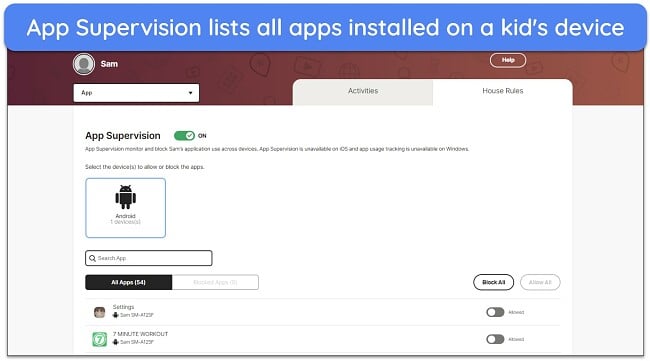 Easily block or allow apps on your child’s device, including recently installed apps
Easily block or allow apps on your child’s device, including recently installed appsBut, I’m not particularly impressed with the App Monitoring feature because it only allows you to block or allow usage of the app. I prefer an additional feature that allows parents to set specific app usage limits, especially social media apps, per day or week. You can only see how much time each app has been used in the past 24 hours, 7 days, 14 days, or 30 days.
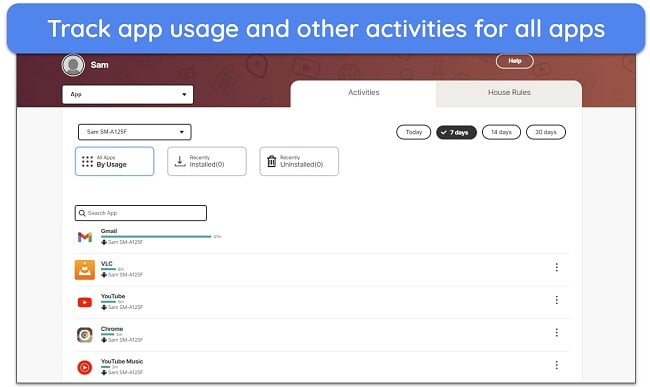 Norton Family app usage tracking shows you installed, uninstalled, and most used apps
Norton Family app usage tracking shows you installed, uninstalled, and most used appsSo, if I notice they are using any app for longer than agreed, the only option is to block the app. App Supervision is unavailable on iOS, and app usage tracking is unavailable on Windows. Another thing to note is that Norton Family lists updated apps as newly installed apps, which can be a bit confusing.
Location Tracking — Set up Geofences and Track Your Child’s Live Location
Norton Family includes a Location Supervision feature for tracking your kids’ location and where they’ve been. The app connects to the phone’s GPS, so it provides a very accurate location. This is especially useful if your child gets lost or loses their device.
Norton Family also includes the “Check In” option for kids to share their location with their parents. Alternatively, parents can send a location-sharing request to their children to approve. I like that the feature works on both iOS and Android devices.
Location Supervision also allows you to set up geofenced zones using the Favorite Locations option. This means you can set predefined zones around the areas your child is expected to be in most days. You’ll get alerts when the child enters or leaves that zone. You can set up geofences up to a radius of 3,200 meters (10,500 feet) from a particular location.
There’s also an “Alert Me” setting that tells you where each kid is located at scheduled times. It’s a feature I find useful if you want to keep track of your child’s location at a particular time during the day, like after they leave school or when they ought to be at sports training. Norton Family’s location tracking sends you updates about your child’s location every 20–30 minutes.
But it’s disappointing that Norton Family does not support Location Supervision in most European countries, including Portugal, Romania, Iceland, Sweden, Luxembourg, Netherlands, Germany, Russia, Spain, as well as Israel and Türkiye.
Video Blocking — Monitor Videos Your Child Is Watching
The video supervision feature monitors YouTube and Hulu videos on your child’s device. It tracks YouTube directly and works on iOS, Android, and Windows. However, Norton Family does not monitor the Hulu videos watched on Android and iOS, only on Windows.
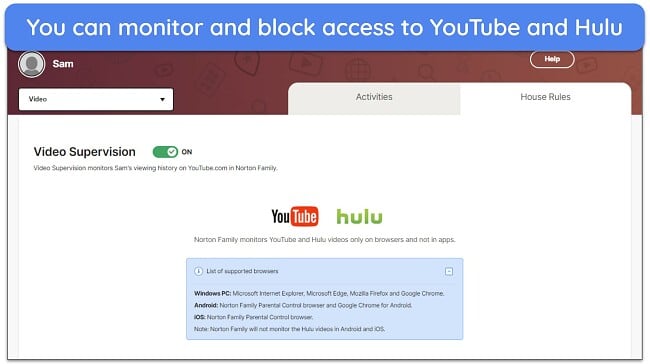 Note that Norton Family does not monitor Hulu videos on Android and iOS
Note that Norton Family does not monitor Hulu videos on Android and iOSThe feature works really well, but like the Search Supervision feature, if your child uses iOS, then Video Supervision only tracks videos watched on the Norton Family browser. On Android devices, Norton Family will track videos watched on both the Norton Family and Google Chrome browsers.
A tech-savvy child can easily circumvent video monitoring. I blocked the apps through the dashboard, but the kids were still able to watch YouTube and Hulu videos on Firefox.
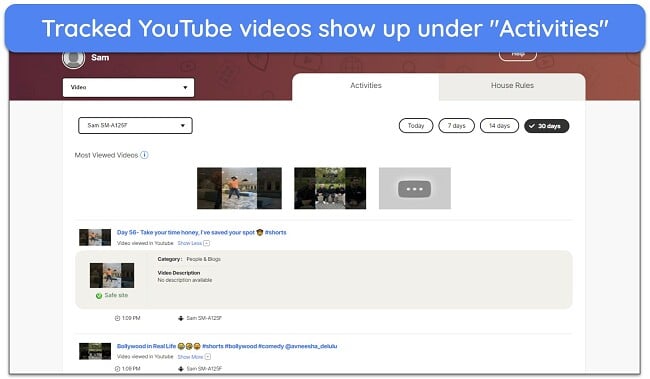 Norton Family also shows you direct links to quickly see the videos your child watched
Norton Family also shows you direct links to quickly see the videos your child watchedIt takes about 20–30 minutes for tracked videos to show up in the parental app. When the tracked videos appear in your dashboard, Norton Family shows a thumbnail screenshot of the video and a direct link that allows you to check out the videos yourself. It also shows you the search terms your child used in the Search Supervision section of your dashboard.
Search Filters — See What Your Child Has Been Searching on the Internet
Norton Family’s Search Supervision feature tracks all your child’s web searches on a few top major search engines. This includes YouTube, Google, and Bing. You can enable safe search through this feature, so these search engines will only list search results that are safe for your kids.
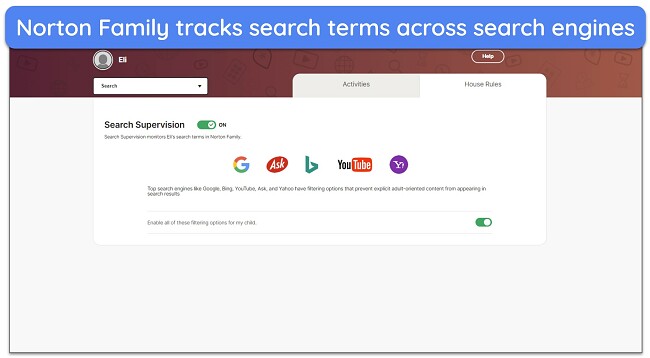
Search Supervision works on iOS, Android, and Windows devices. But kids can still use other search engines that Norton Family cannot track. On iOS devices, the Search Supervision feature only tracks your search queries on the Norton Family browser. So, they can easily circumvent the search feature if they use Chrome or Firefox browsers.
The only way to avoid this is to block the apps directly from your dashboard. This leaves them with the Norton Family browser as the only option. It’s a bit better on Android, as it tracks Google Chrome, the default Android browser, and the Norton Family browser.
On Windows, the Search Supervision works on all the supported search engines via the Norton Family browser extensions. But, your child can easily disable the extension.
Extra Features — Make the App Easy to Use, Safe, and Reliable
In addition to its core parental control functionalities, Norton Family offers a range of supplementary features for added convenience for parents:
- Uninstall Protection — A crucial feature that prevents children from uninstalling the Norton Family app to bypass parental controls.
- Instant Lock — Enforces immediate restrictions on a child’s device. When you enable Instant Lock, the child can only call an emergency contact on their device. Consider sharing the 4-digit PIN generated in your dashboard with your child for emergencies.
- Two-Factor Authentication — Adds an extra layer of security to your Norton Family account.
- Auto Logout — Logs you out after a prolonged period of inactivity in the app. This reduces the risk of unauthorized access to your dashboard.
Ease of Use
You can easily set up Norton Family on your computer and your children’s devices. Overall, the download, installation, and setup took less than 15 minutes. I like that you can customize the rules for each according to their ages.
Norton Family works well on Windows, Android, and iOS devices. With a single subscription, Norton Family allows you to add and monitor unlimited devices, making it an ideal choice for large families. However, the App Monitoring feature isn’t available on iOS devices, and Norton Family doesn’t support macOS at all.
You can manage everything through the Parent Dashboard. It has a well-designed layout, which gives you a quick overview of everything going on. When you click on a child’s name and select View Profile, you will see additional details about the child. You can also add more devices to each child’s profile.
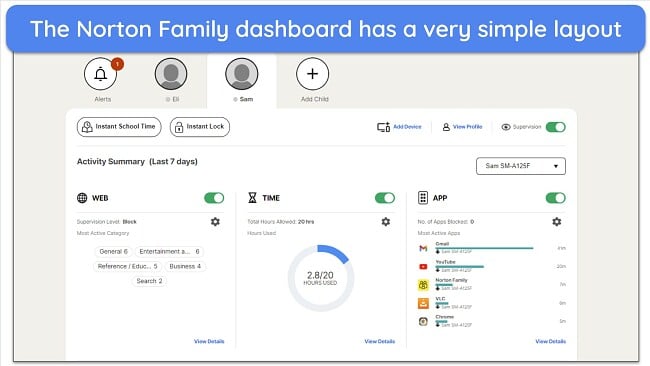
When you click on the View Activity Details link, it will give additional details about a particular feature. On the top of the page are 2 tabs: House Rules and Activities. Activities give you all the information about a specific feature. For example, which apps are being used, for how long, how much time has the child been online, their additional time requests, sites visited, and more.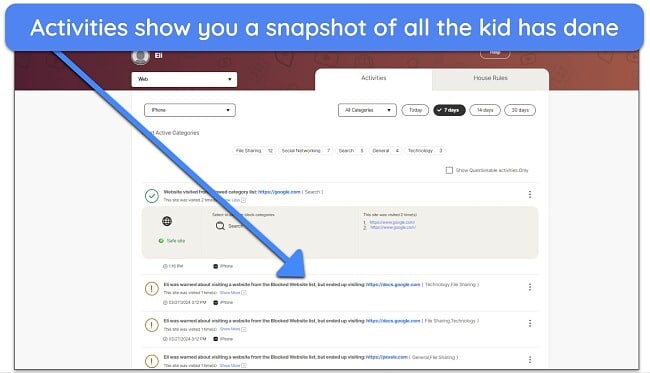
Support
Norton Family provides robust customer support and a vast library of support resources, including FAQs, setup tutorials, troubleshooting guides, and informative articles on how to use its features. It also has a 24/7 live chat, unlike most competitor parental control apps.
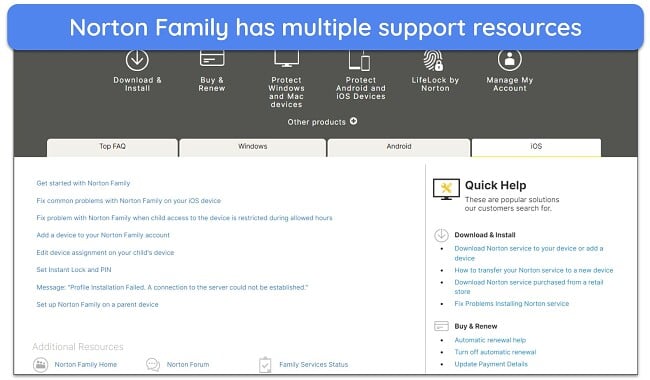
During the installation, I encountered an error while configuring the child app on iOS. When I reached out to the support team via live chat, I was initially answered by a bot, but it quickly connected me to a live support agent.
While the support agent asked me to uninstall and reinstall the child app and then start the configuration afresh, it wasn’t quite the solution I needed. I discovered that there was an existing profile configuration that I had to remove to enable me to complete the installation and connect the child app with the parent app.
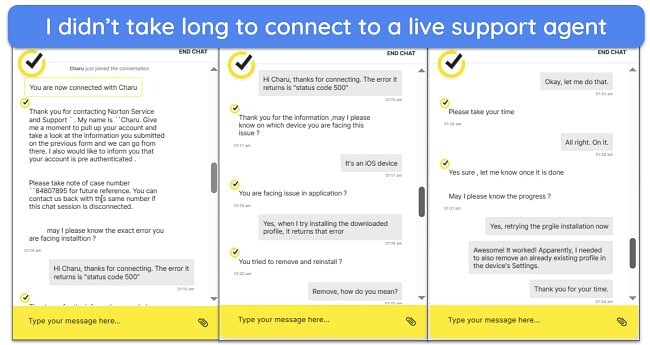
You can also get support on social platforms, such as Facebook and Twitter, and 24/7 phone support in 50+ countries. Some users have complained that many of Norton Family’s support representatives are not responsive or very knowledgeable. This was exactly the case in my experience, as I ended up fixing the problem myself using the guide on the help page.
Pricing
Norton Family offers a 30-day free trial that allows you to explore its features without restrictions. It also has a paid yearly plan and comes bundled with other Norton plans, including the antivirus, password manager, LifeLock, and Cloud Backup.
I was able to set up my subscription using my PayPal account. Norton Family also accepts credit/debit cards, Apple Pay, and Google Pay. Plus, you get a 30 money-back guarantee on the annual plan.
Norton Family Standalone Subscription
You can get Norton Family as a standalone subscription for $49.99/year. While this is a relatively good price compared to other available options, the Norton Family app does not offer a monthly subscription.
Norton Family Bundled Subscriptions
The Norton 360 Deluxe, Norton 360 Premium, and Norton 360 with LifeLock plans all have Norton Family bundled in. Norton is called Parental Control in these bundled plans.
1. Norton 360 Deluxe — This plan ( /year) extends protection to up to 5 devices. It includes all the features of the Standard plan, such as antivirus, malware, ransomware, and hacking protection, along with the 100% Virus Protection Promise. It also includes a 50GB Cloud Backup, a Password Manager, and a VPN private internet connection.
2. Norton 360 Premium — Norton 360 Premium ($54.99 first year) annual plan bundles in Norton Family and offers multiple layers of protection for devices and online privacy for the whole family. It includes everything in the 360 Deluxe plan, protects up to 10 PCs, Macs, smartphones, or tablets simultaneously, and comes with a 60 money-back guarantee.
3. Norton 360 with LifeLock — The Norton 360 with LifeLock plan ($99.99 first year) covers up to 10 devices and includes advanced security features. Alongside the malware and hacking protection, it also offers a 250GB Cloud Backup, a Password Manager, and a VPN.
Bottom Line
Norton Family is a reliable and competitively priced parental control software. It offers a comprehensive set of features, such as web filtering, app monitoring and blocking, search filters, screen time limits, and location tracking, designed to help parents monitor and manage their children’s online activities effectively.
The parental control dashboard is intuitive, and the app is easy to set up on your children’s devices. I like that it comes with default house rules and website filters for different age categories. But, I think Norton Family should also include an app usage limit per day or week and allow web filtering and video monitoring on all popular browsers.
Particularly disappointing is Norton Family’s lack of support for macOS and app-tracking features on iOS. You also cannot block apps on your kids’ devices during school hours unless you block access to their phones altogether. And if your child is tech-savvy enough, they can bypass the web filtering on Windows.
FAQ
Is Norton Family safe?
Yes, Norton Family is safe for parents looking to protect their children online. It offers robust web filtering capabilities to block access to explicit content, such as drugs, violence, and pornography. The software also enables parents to track their child’s online activity, including searches and YouTube video views, ensuring they are not exposed to inappropriate content.
Can VPNs get around Norton Family’s restrictions?
No, even top-rated VPNs cannot bypass Norton Family’s restrictions. During my tests with various popular VPNs on both mobile and desktop devices, Norton Family’s parental app effectively maintained its web filtering capabilities. Norton Family was able to detect and block the VPNs that I attempted to use.
Can Norton Family restrict app usage?
Yes, Norton Family can restrict app usage for almost all apps. With its App Supervision feature, parents can block or allow the use of certain apps on their children’s devices. However, this feature is only available on Android devices. Generally, parents can set specific rules that limit phone screen time, which also restricts access to all installed apps on a child’s device.
Can I use Norton Family to monitor texts and calls?
No, Norton Family doesn’t support monitoring texts and calls. But, its App Monitoring features allow you to monitor app usage on Android devices. Previously, it allowed parents to monitor text messages and block phone calls when kids exceeded screen time limits on Android devices. However, due to policy changes by Google, Norton Family discontinued this feature.
Is there a free version of Norton Family?
No, Norton Family doesn’t offer a free plan. Instead, Norton Family offers a 30-day free trial for parents to explore the app’s capabilities before committing to a subscription. It also provides competitively priced paid plans with a 30 money-back guarantee, allowing you to purchase it with confidence.
What are the screen time prevention tools on Norton Family?
Norton Family offers several screen time prevention tools to help parents manage their children’s device usage effectively. These tools include:
- Time Supervision — You can set specific time limits for your children’s device usage, allowing you to control the amount of time the kids spend on each device daily.
- Instant Lock — This feature allows you to instantly lock your children’s devices, restricting access to all apps except emergency calls to trusted contacts.
- School Time — Norton Family’s School Time feature restricts web usage during school hours, ensuring that the kids stay focused on their studies and avoid distractions from online activities.
- App Supervision — You can monitor and control the apps installed on your kids’ devices, limiting access to inappropriate or time-consuming apps.
Can my kids bypass the Norton Family restrictions?
No, Norton Family implements uninstall protection, which requires parental account login credentials to remove the apps, so your children cannot secretly uninstall them. Also, there’s an Instant Lock feature that disables device access, with only emergency calls allowed.
Its two-factor authentication adds an extra layer of security, such that no one can access the parent’s dashboard even if they manage to get the password. Finally, the auto-logout feature signs you out after a period of inactivity, preventing unauthorized access to settings in the parent’s account if it’s left logged in.

